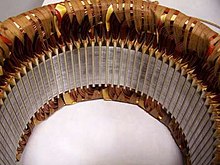Stator
Originally applied to low-power applications, PCB stators can be lighter, smaller, and less noisy.
[2] One design embeds thin copper traces in the PCB stator that serve as the windings.
Depending on the configuration of a spinning electromotive device the stator may act as the field magnet, interacting with the armature to create motion, or it may act as the armature, receiving its influence from moving field coils on the rotor.
This is necessary because a continuously moving power switch known as the commutator is needed to keep the field correctly aligned across the spinning rotor.
A stator can reduce the turbulence and rotational energy introduced by an axial turbine fan, creating a steady column of air with a lower Reynolds number.




